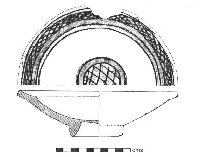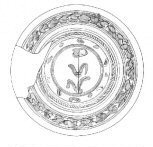The earliest recorded evidence of sgraffito wares in the medieval period is in northern Italy where they were copying Middle Eastern and Eastern Mediterranean prototypes. The main production centres were in the Po Valley and in Liguria (Hurst et al. 1986, 30).

In Liguria, north-west Italy, during the end of the 12th century and beginning of the 13th century, there was a decline in local ceramic production and substantial quantities of Islamic and Byzantine pottery were imported. This led to a change in local consumption and in pottery production. A ware called Tirrenian Archaic Graffita was created, the more correct term being Savona Archaic Graffita. Genoa had close trading links with the Eastern Mediterranean at this time and it is suggested that craftsmen from there brought new potting techniques to Liguria and developed the Savona Archaic Graffita industry, possibly as an entrepreneurial operation (Benente et al. 1993). The pottery was exported to other parts of Italy, Provence, Sardinia and Sicily. Savona Archaic Graffita lasted throughout the 14th century and on a limited scale until the mid 15th century.

Figure 18: Ligurian Archaic Graffita (after Benente et al.
1993, 16)
The fabrics vary in colour, with the slip a whitish-grey, sometimes slightly pink, applied over the internal surface only. The sgraffito was enhanced by brush strokes of copper green and iron yellow, the glaze being clear or yellow. Dishes are the most common form, others being plates, basins and large bowls. There are at least 20 different decorative motifs used on the flanged rims, with at least ten other designs inside the centre of the vessels. Lattice is used most frequently inside and on the rim. Geometric and plant motifs are also common with four or five basic designs. The most common animal themes are fish and bird. Heraldic motifs are derived from oriental designs on Islamic and Byzantine wares (ibid, 14).
In the 15th century, monochrome graffita ware was produced in the area, made of the identical clay, and possibly by the same potters. The forms were similar to Savona Archaic Graffita. It is suggested that this was to supply a different market (ibid, 21). Basins, dishes and plates were produced with a brown, yellow or green glaze. The earliest form of decoration was a central cross with undulating rays. This was later modified into a tripartite motif. Less common designs were stylised heraldic arms, floral motifs, human faces or ships. Production of this ware continued into the 16th century.
By the 15th century, Pisa had become an important production centre. The wares produced in Pisa were the most traded. They have been given the name graffita tarda (late sgraffito). The trade increased substantially in the 16th and 17th centuries with exports throughout the Mediterranean to Egypt and Turkey and west to Southern France and Spain and up the English Channel along both sides of the North Sea (Hurst et al. 1986, 30).
The fabric is a hard, fine red with white slip inside and a lead glaze, producing a yellow finish. Forms are mainly dishes and bowls. The decoration in the 16th century was incised through the slip to form red patterns on a yellow background. Typical designs were central rosettes and shields with foliage or geometric borders. Also fishes, inscriptions and birds were used. The 17th-century decoration was mostly polychrome with a flowery stem and the geometric borders were simplified. This later ware has been found in Devon and Virginia, USA (ibid, 32).

Figure 19: Pisa bowl with sgraffito floral decoration. Rim diameter
228mm. (After Hurst et al. 1986, 32)
Saintonge, south western France, was producing three types of ware in the 13th and 14th centuries, one of which was sgraffito. The sgraffito decoration was incised through a brown slip on high quality pottery made with a pale coloured clay (Barton 1980, 45-46). These wares were exported along the French Atlantic and Channel coasts, to the British Isles and also to Flanders and Scandinavia (Chapelot 1983, 51). All the forms are jugs.
Saintonge sgraffito jugs have been found in Britain along the south coast from Cornwall to Kent. One site in Devon produced this ware in a pre-1300 context (Allan 1983, 202). It has also been found at sites around the Irish Sea in Ireland and south Wales (Davey 1983). Several sherds were found in Bristol Castle dated to c. 1300 (Ponsford 1983, 222).
Davey considered Saintonge sgraffito to be 'fairly common' in frequency around the Irish Sea province in the period 1200-1500. The Saintonge region in particular, and France in general, dominated the imports coming into the Irish Sea at this time (Davey 1983, 215).
Saintonge sgraffito was found in a pit in Dublin (Ireland) along with Saintonge polychrome and a Spanish malaga jar, dated to the late 13th century. The influx of Saintonge pottery in the later 13th century is attributed to the acquisition of Aquitaine on the marriage of Eleanor to Henry II. There is a possibility that the bulk of Dublin's imports from south west France came from a small area of Saintonge which specialised in pots for export to Dublin (Wallace 1983, 228).
In the 14th and 15th centuries a form of sgraffito ware was being produced in Cambridge. It is described as hard red ware, partly covered by a buff slip through which designs are incised. It has a clear yellowish glaze which is sometimes flecked with green (McCarthy and Brooks 1988, 424). The forms are mainly jugs and the decorative motifs are floral, fish and geometric. The source is unknown but may be fairly local to Cambridge. Similar sgraffito-decorated jugs have been found in Essex (ibid, 444).
© Internet Archaeology URL: http://intarch.ac.uk/journal/issue16/1/ch7.1.html
Last updated: Wed Mar 24 2004